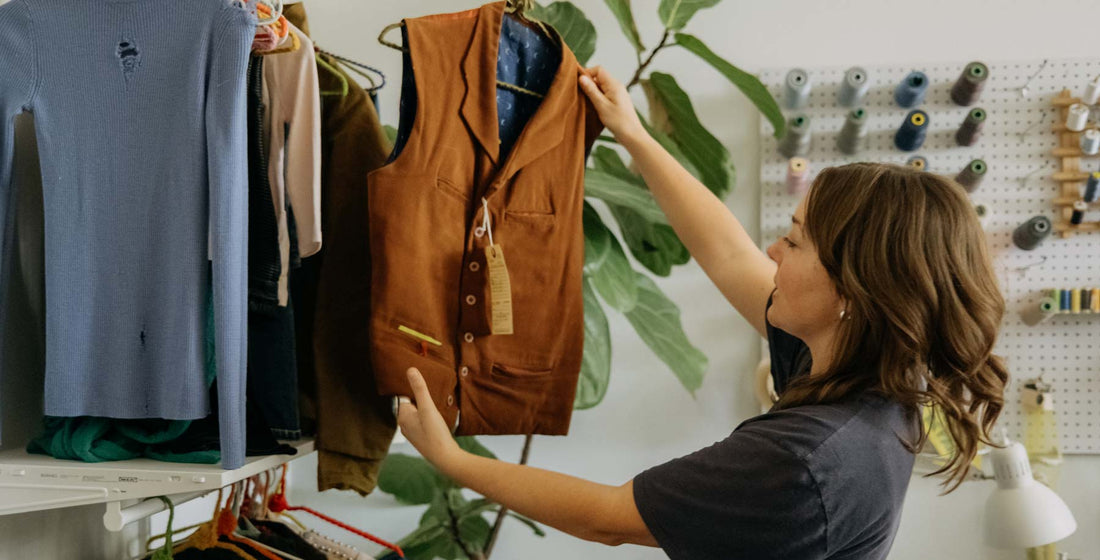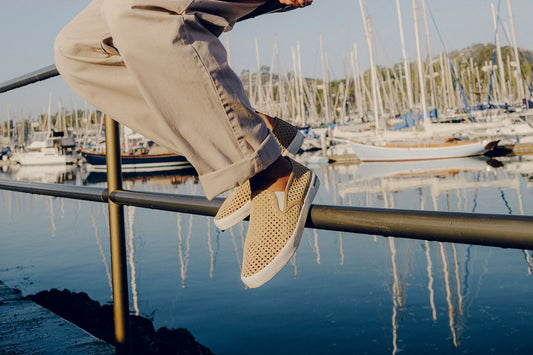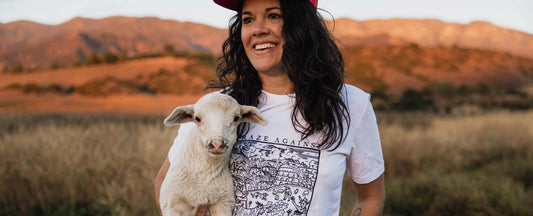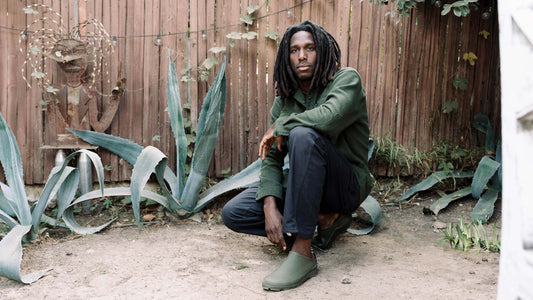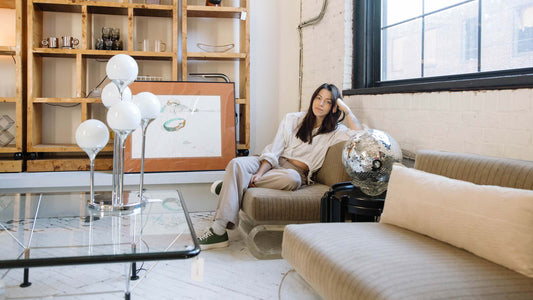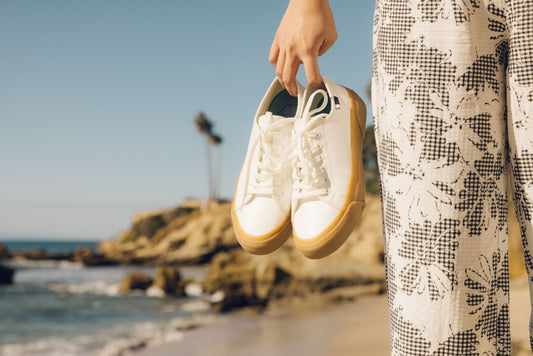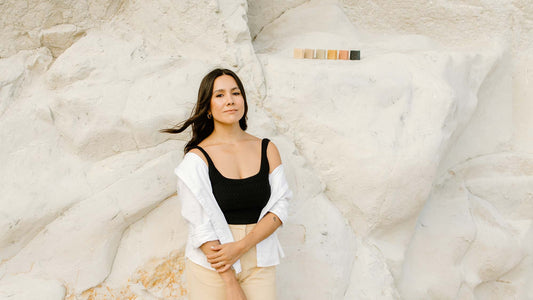Claire Beaumont hasn’t had a boss since leaving her corporate job, but she does seem to have a supervisor. “I’ve been rewatching The Muppet Show lately and just sobbing through every episode,” she laughs, pointing to the stuffed Kermit doll keeping watch over her sewing studio. “I actually started writing a children’s show about clothing repair. There’s a pair of patched-up pants named Patches and a sewing machine named Stitch.”
If anyone is qualified to introduce the concept of a circular economy to children, it’s Claire. She’s been working as a patternmaker, fabricator and clothing repair educator for more than fifteen years, heading up the Restoration Department at Filson, traveling the country with Patagonia’s Worn Wear program, and helping designers explore sewing and patternmaking techniques at Nike’s Blue Ribbon Studio. Now, she’s using her own mail-in repair business, FOREVERYWEAR, to keep the clothing we love in circulation and fulfill a lifelong dream of turning her passion into purpose.
As told to SeaVees. Photography by Johnie Gall.


“When I was a kid I saw this pair of sweatpants that had a denim waistband and pockets—my mom wouldn’t buy them for me, so I went home and figured out how to make them myself. I cut off the top of some old jeans and glued and stapled them onto some sweatpants and I think it was just embarrassing enough for my parents that they gifted me a sewing machine [laughs].
There was no Youtube back then, and I’m not great with written instructions, so I taught myself to sew. When I was a senior in high school, we were asked to come up with a thesis project and I wrote an entire business plan for a reconstructed clothing store in Seattle and sewed a collection of seven pieces I reconstructed from the thrift store.
I guess I’ve always been passionate about repurposing things. My mom worked as a book merchandiser and I would sit next to her in different Target stores as she changed out book displays. She’d have to rip the covers off of the books she was taking down and throw them away. Even though they were shitty romance novels, I remember being so upset and feeling like people could use them. Then my dad worked in DVD sales for Disney, and he’d get all these promotional backpacks and hats that said things like Lion King 1 ½ or Toy Story 3 on them. I was always excited to have new things, but I was mad that they had promotional embroidery on them and I didn’t want to be a walking advertisement, so I was always covering them up with patches.

My sister was working at Filson and she gave me a tour of the offices and factory. She took me by their newly formed Restoration Department and there was only one employee working there artfully restoring old bags. His name was Evan, and I asked if he could help me repair the zipper on my backpack. We sat together for hours as he showed me how to repair the bag and let me do some of the sewing myself. We were really excited about each other’s sewing skills and he was like, ‘Man, you should come with me in this department, I wish there was a job opening.’ I’d never wanted a job so badly in my life! A few months later, a position opened up for a Restoration Department Coordinator, and I moved back to Seattle to take it. Evan got the final say in the hiring process and said to his supervisor, 'Claire is the one.' And his supervisor said, 'I know, but you should also hire her' [laughs]. We’ve been together ever since.
“We were repairing and reselling items for almost double their original value, and I think that was really interesting for other brands to see.”
It was the first time I had seen a company of that size not only take responsibility for the pieces they sold, but prove there was a lot of value in old materials. We were repairing and reselling items for almost double their original value, and I think that was really interesting for other brands to see. It was a huge education for me because I was working directly with the factory and getting to use production machines and learn how to execute these incredibly technical repairs. But I was frustrated, because a lot of the time customers wanted their bag back and the company would just send them a new version. Breaking in a Filson bag is a right of passage for a lot of people, and there was no option for them to hang on to the bag they’d probably planned to pass down to their kids.


Evan and I had been dreaming about moving into a van and traveling the country repairing clothes when we heard Patagonia launched their Worn Wear clothing repair program—we joined the second tour, which took us to college campuses all over the country. I was so nervous when the first student walked up to me with a repair. He handed me these cheap sweatpants which, to me, seemed like they had no value. But he was like, ‘These are my favorite sweatpants, I’m obsessed with them, can you please fix these?’ Throughout the Worn Wear tour, I started to learn what repair is really about: it doesn’t matter how much you spend on something if it has emotional value. The longer you own a piece of clothing, the more stories it collects and the less disposable it feels. I think we’re losing that emotional connection to the things we buy because they aren’t built to last and it’s often cheaper to buy a new thing than to repair what you own.
“I realized I’d uprooted my entire life at the beginning of a pandemic to help build someone else’s dream.”
I moved to Los Angeles to help run an upcycling factory that was making new clothes out of old clothes on a large scale. I was brought on to eventually take over the business, which felt like the climax of all these things I’d been working toward, but it became very clear once I got there that the owner had no plans to follow through on that promise. It was a really unhealthy environment and I left two months in. I realized I’d uprooted my entire life at the beginning of a pandemic to help build someone else’s dream and I walked away. I spent the next two years in a pretty dark place.

It took me a long time of asking myself the hard questions to figure out how I wanted to show up in the world and what I wanted to contribute to the ‘sustainable fashion’ industry. My unemployment was running out and there was this reality of needing to make money. I’d piloted the idea of a mail-in repair service to keep me afloat between tours with Patagonia, so I decided to relaunch it in a more formal way. I got a post office box and sent an email out to friends and family to help garner some financial support on a GoFundMe. I raised $4,000 which helped me get the basic supplies I needed to get off the ground.
“It took me a long time of asking myself the hard questions to figure out how I wanted to show up in the world.”
I got lucky when one of my videos blew up on Instagram with over a million views— I joke that there were little algorithm gnomes helping me out because they believed in reuse and repair. I still don’t have a website because most people find me through social media or word of mouth. I did repairs on a sliding pay-what-you-can scale at first as a study in generosity, but I pretty quickly realized that to make it a worthwhile business I needed to approach it differently. I work very efficiently so it doesn’t behoove me to have an hourly rate. Right now I now have a $100 minimum on repair orders and I’m still learning how to put a fair value on what I do.


Everything I do is through the mail, and I don’t want to take business away from local tailors, so I specialize in the repairs that you don’t trust with anyone else or your mom’s friend has turned away [laughs]. One friend sent me a family heirloom cowichan sweater made by her grandmother that needed a new zipper. I had a denim jacket come through recently that had been the owner’s grandfather’s, and he’d worn it all through his punk years and had sewn a T-shirt onto the back of it. It was completely falling apart and I was able to buy him another five or ten years of wear.
Sewing can be a really vulnerable thing. You can learn a lot about a person’s thought process from looking at something they’ve sewn. I’m always thinking about the future repairability of the garment: ‘if I stitch over the seams here, they’ll be too dense to repair next time.’ There are ways of doing things that will make an item last longer or wear better over time and my goal is to always make things last as long as possible. I often feel really nervous and scared about certain repairs I have to do, but then I remember that I trust myself, I have the experience and am good at what I do.

What I’ve come to learn through years of studying the industry is that we really lack the infrastructure for circularity. We can make clothing more sustainably, but that doesn’t fix the issue that we still can’t repair or recycle them when the time comes. I see my contribution to a circular economy as creating services and infrastructure to keep your clothes going because the most sustainable piece of clothing is the one already in your closet.
I’m in a business accelerator program right now and working on a business plan for how to scale this up and build a team of repair professionals. I want to create a repair training program to teach others and make this service more accessible. Right now my job is to show proof of concept by demonstrating growth and proving demand through my waiting list. I don’t just want to teach people how to do the technical repairs, either—I want to teach my entire philosophy.
“Starting and running a business feels like the easiest thing I’ve ever done because it’s the most natural thing I’ve ever done.”
I knew what I wanted to do from a really young age and never gave up on it. I kept building and diversifying my skills until I just happened to be the most qualified candidate for all of my dream jobs. Starting and running a business feels like the easiest thing I’ve ever done because it’s the most natural thing I’ve ever done. With every other job, there’s been some aspect of myself I had to change in order to fit the mold of what was required of me, but with my own business I’m the designer and it feels like a dream to get to design my own life.


With everything we’ve been through in the last few years, it doesn’t always feel safe to take a risk. But there are so many resources out there to help support you in taking that risk, especially for small businesses or underrepresented founders. My dream for others is that they find a way to take their values and go and learn the skills they need to use them to contribute to making the world a better place. If there’s something you desire to see in the world, there’s going to be other people out there with the same desire. I used to think if I worked for a bigger company, I’d be able to have a bigger impact on the world, but there’s so much power in creating small businesses that offer an alternative way of living.”
Claire wears the SeaChange LTT in Deep Ocean. Every sale supports SeaTrees, a nonprofit that works to restore coastal ecosystems and ocean health globally.

